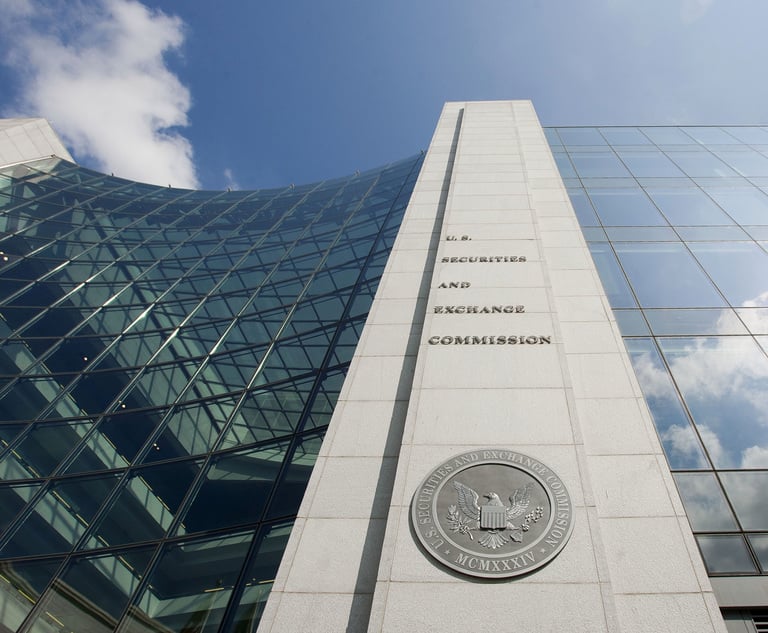Is the “Halo Effect” Making Angels Out of Infringers?
On the surface, the Halo Effect seemed to have been a victory for patent owners, but has it really worked out that way?Historically, patent owners have…
June 29, 2017 at 09:23 AM
5 minute read
The original version of this story was published on Law.com
On the surface, the Halo Effect seemed to have been a victory for patent owners, but has it really worked out that way?
Historically, patent owners have pled willful infringement to support enhanced damages from an infringer. But over the years, the courts have made it more and more difficult to prove willful infringement, culminating with the Federal Circuit's ruling in In re Seagate. Seagate set up a two-part test that made it hard to establish willful infringement as well as to obtain enhanced damages.
In June 2016, the Supreme Court ruled in Halo Elecs., Inc. v. Pulse Elecs. Inc. that the Federal Circuit's Seagate analysis for willfulness was too restrictive. The Court restructured the willfulness analysis to eliminate the objective recklessness analysis, and lowered the burden of proof from a convincing standard to a preponderance of the evidence standard. Also, the court held that an award of enhanced damages is in the discretion of the district court to be awarded in egregious cases.
On the surface, this seemed to have been a big victory for patent owners. A lower the burden to prove willful infringement seemed as if it should be a deterrent to patent infringement. But, has it really worked out that way? James Gumina, partner at intellectual property law firm McDonnell Boehnen Hulbert & Berghoff LLP, sat down with Inside Counsel to discuss willful infringement in a post-Halo setting.
There are two main reasons for pleading willful infringement, according to Gumina. First, the patent statute allows for the court to award enhanced damages in exceptional cases. The principle way to demonstrate that a case is exceptional is to prove willful infringement. Pre-Halo, a finding of willful infringement generally led to enhanced damages, so if the court did not enhance damages, it was obliged to explain why it did not do so. Second, pleading willful infringement provides litigation advantages. This allows a plaintiff to argue more of the equities of the situation, however, since a case of patent infringement does not require proof of intent, it is difficult to argue that the infringer is a bad actor.
“Pre-Halo that standard for proving willful infringement was quite high,” he explained. “As set forth in Seagate courts require clear and convincing evidence and two levels of proof – subjective and objective willfulness. Yes, over the years it became more and more difficult to reach this standard.”
The Halo Court dealt with the concept of an exceptional case under Section 284 of the patent statute. Willfulness is wrapped up in that analysis but they are not necessarily co-extensive. The Court felt that the Seagate test was allowing the worst infringer to escape enhanced liability, according to Gumina.
“Basically, if they could muster a reasonable defense in litigation then they could avoid a finding of willfulness and thus an exceptional case,” he said. “The court believed that the focus of this analysis was incorrect and it should focus on the time infringement began. They also believed that the clear and convincing standard was not supported by the statute and that the lower standard of preponderance should be applied.”
Has this really been a victory for patent owners? Even though it is easier for a patent owner to establish willful infringement, the impact of that finding is not what it used to be. The Halo court set up a standard of egregiousness that is vague, leaving the award of enhanced damages to the discretion of the district court judge. If a judge believes an infringer was “willful” but not “egregious” then likely there will be no enhanced damages. It there is truly an egregious case, i.e., the infringer is a blatant copier, then, it is easier for the patent owner to establish an exceptional case and obtain enhanced damages.
“I think that the change in the standard form clear and convincing to preponderance will have little effect,” explained Gumina. “In most cases, willfulness is a jury issue and with juries that distinction is lost.”
Today, many courts are exercising their discretion to not award enhanced damages even considering a jury finding of willful infringement. They are going beyond the prior proofs and looking at the read factors to make the evaluation. In fact, according to Gumina, the Supreme Court indicated that for a case to exceptional it would have to stand out from the normal case and that enhanced damages were intended to address acts of a “pirate.”
He added, “Perhaps as more cases are tried under the Halo standard and plaintiffs put in evidence directly addressing the Read factors more courts will see fit to enhance damages. But in my view, at least in most case, simply proving willful infringement alone will not result in an award of enhanced damages.”
- Further reading:
- The fallout from Halo: Opinions of counsel and the evolving standard for willfulness
- One and Done: Tripped Up by Standing–Some Patent Challengers Who Lose PTAB Trials Cannot Appeal
- Living in a Post-Lexmark World: What Happens Next?
- TC Heartland Decision May Have Major Implications for Patent Litigation
This content has been archived. It is available through our partners, LexisNexis® and Bloomberg Law.
To view this content, please continue to their sites.
Not a Lexis Subscriber?
Subscribe Now
Not a Bloomberg Law Subscriber?
Subscribe Now
NOT FOR REPRINT
© 2024 ALM Global, LLC, All Rights Reserved. Request academic re-use from www.copyright.com. All other uses, submit a request to [email protected]. For more information visit Asset & Logo Licensing.
You Might Like
View All
SEC Penalizes Wells Fargo, LPL Financial $900,000 Each for Inaccurate Trading Data

US Reviewer of Foreign Transactions Sees More Political, Policy Influence, Say Observers

Pre-Internet High Court Ruling Hobbling Efforts to Keep Tech Giants from Using Below-Cost Pricing to Bury Rivals
6 minute read
Preparing for 2025: Anticipated Policy Changes Affecting U.S. Businesses Under the Trump Administration
Trending Stories
- 1Trailblazing Broward Judge Retires; Legacy Includes Bush v. Gore
- 2Federal Judge Named in Lawsuit Over Underage Drinking Party at His California Home
- 3'Almost an Arms Race': California Law Firms Scooped Up Lateral Talent by the Handful in 2024
- 4Pittsburgh Judge Rules Loan Company's Online Arbitration Agreement Unenforceable
- 5As a New Year Dawns, the Value of Florida’s Revised Mediation Laws Comes Into Greater Focus
Who Got The Work
Michael G. Bongiorno, Andrew Scott Dulberg and Elizabeth E. Driscoll from Wilmer Cutler Pickering Hale and Dorr have stepped in to represent Symbotic Inc., an A.I.-enabled technology platform that focuses on increasing supply chain efficiency, and other defendants in a pending shareholder derivative lawsuit. The case, filed Oct. 2 in Massachusetts District Court by the Brown Law Firm on behalf of Stephen Austen, accuses certain officers and directors of misleading investors in regard to Symbotic's potential for margin growth by failing to disclose that the company was not equipped to timely deploy its systems or manage expenses through project delays. The case, assigned to U.S. District Judge Nathaniel M. Gorton, is 1:24-cv-12522, Austen v. Cohen et al.
Who Got The Work
Edmund Polubinski and Marie Killmond of Davis Polk & Wardwell have entered appearances for data platform software development company MongoDB and other defendants in a pending shareholder derivative lawsuit. The action, filed Oct. 7 in New York Southern District Court by the Brown Law Firm, accuses the company's directors and/or officers of falsely expressing confidence in the company’s restructuring of its sales incentive plan and downplaying the severity of decreases in its upfront commitments. The case is 1:24-cv-07594, Roy v. Ittycheria et al.
Who Got The Work
Amy O. Bruchs and Kurt F. Ellison of Michael Best & Friedrich have entered appearances for Epic Systems Corp. in a pending employment discrimination lawsuit. The suit was filed Sept. 7 in Wisconsin Western District Court by Levine Eisberner LLC and Siri & Glimstad on behalf of a project manager who claims that he was wrongfully terminated after applying for a religious exemption to the defendant's COVID-19 vaccine mandate. The case, assigned to U.S. Magistrate Judge Anita Marie Boor, is 3:24-cv-00630, Secker, Nathan v. Epic Systems Corporation.
Who Got The Work
David X. Sullivan, Thomas J. Finn and Gregory A. Hall from McCarter & English have entered appearances for Sunrun Installation Services in a pending civil rights lawsuit. The complaint was filed Sept. 4 in Connecticut District Court by attorney Robert M. Berke on behalf of former employee George Edward Steins, who was arrested and charged with employing an unregistered home improvement salesperson. The complaint alleges that had Sunrun informed the Connecticut Department of Consumer Protection that the plaintiff's employment had ended in 2017 and that he no longer held Sunrun's home improvement contractor license, he would not have been hit with charges, which were dismissed in May 2024. The case, assigned to U.S. District Judge Jeffrey A. Meyer, is 3:24-cv-01423, Steins v. Sunrun, Inc. et al.
Who Got The Work
Greenberg Traurig shareholder Joshua L. Raskin has entered an appearance for boohoo.com UK Ltd. in a pending patent infringement lawsuit. The suit, filed Sept. 3 in Texas Eastern District Court by Rozier Hardt McDonough on behalf of Alto Dynamics, asserts five patents related to an online shopping platform. The case, assigned to U.S. District Judge Rodney Gilstrap, is 2:24-cv-00719, Alto Dynamics, LLC v. boohoo.com UK Limited.
Featured Firms
Law Offices of Gary Martin Hays & Associates, P.C.
(470) 294-1674
Law Offices of Mark E. Salomone
(857) 444-6468
Smith & Hassler
(713) 739-1250






